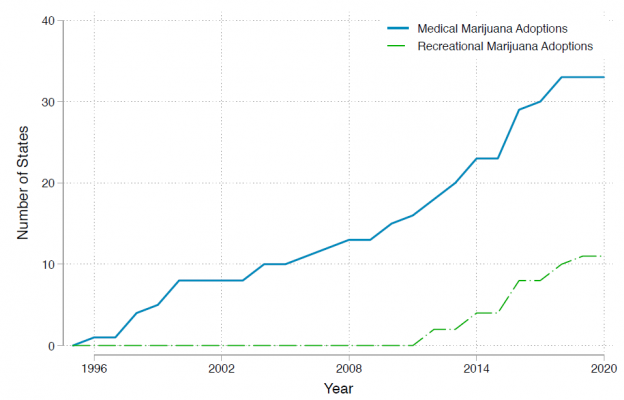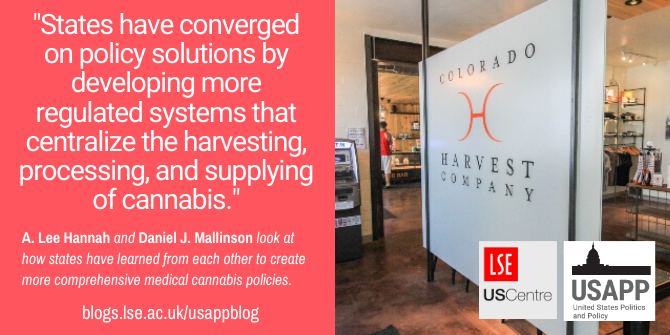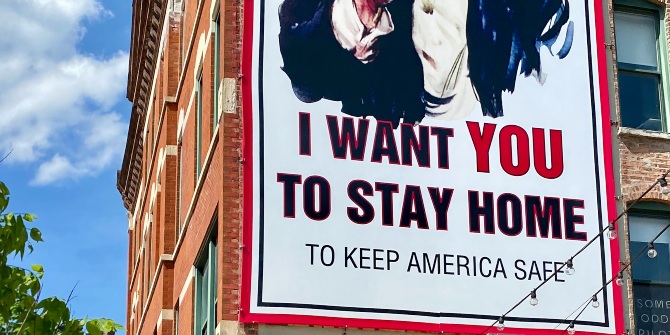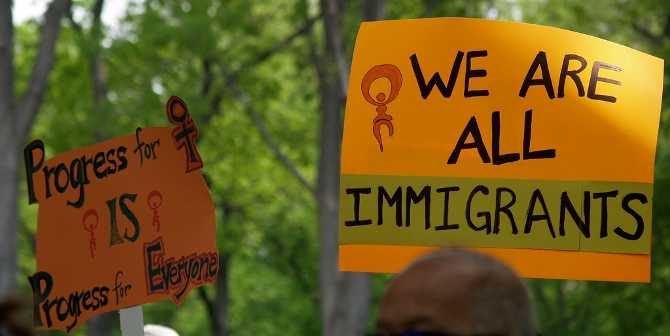
 Medical cannabis was first legalized in California in 1996 – since then, 32 more states have done the same, and 11 have made the drug legal for recreational use. A. Lee Hannah and Daniel J. Mallinson take a close look at how the US states have learned from each other on how to regulate cannabis in the face of a continuing federal ban. They write that the states have moved on from their initially vague laws, enacting measures which exert much closer control over the production and distribution of cannabis.
Medical cannabis was first legalized in California in 1996 – since then, 32 more states have done the same, and 11 have made the drug legal for recreational use. A. Lee Hannah and Daniel J. Mallinson take a close look at how the US states have learned from each other on how to regulate cannabis in the face of a continuing federal ban. They write that the states have moved on from their initially vague laws, enacting measures which exert much closer control over the production and distribution of cannabis.
When California became the first state to pass a medical cannabis initiative in 1996, Democratic Senator Diane Feinstein argued that Proposition 215, which made the medicinal use of the drug legal, was so poorly written that “you’ll be able to drive a truckload of marijuana [sic] through the holes in it.” Her depiction of California’s law, and other early adopters’ laws, is not wholly inaccurate. However, medical cannabis policies have become increasingly complex and institutionalized, as we describe in our recent work.
In previous posts, we discussed how cannabis policies were adopted by the US states – especially in light of federal prohibition. We also addressed the challenge of rolling back state cannabis liberalization. In our latest work, we set out to learn about what has been passed. We find that state cannabis policies and regulations have become increasingly complex over time. The earliest adopting states wrote vague laws that essentially greenlit cannabis for medical use – providing patients an affirmative defense from state cannabis prosecution and allowing them the opportunity to grow or purchase a personal supply of cannabis – but created little structure beyond that. They did so out of fear from federal threats of prosecution for state workers engaged in implementing cannabis programs. So, states simply turned a blind eye to use for medical purposes. Recent laws, however, not only enable, but directly regulate and legitimize an industry that remains expressly prohibited by federal law. It is one thing to turn a blind eye to the violation of federal law, it is quite another to build up an intricate infrastructure to support it. So, what happened?
States operated in legally perilous territory where cannabis was concerned during the Clinton and Bush Administrations. When President Obama’s Department of Justice (DOJ) issued the Ogden Memo, stating that federal prosecutors “should not focus federal resources in your states on individuals whose actions are in clear and unambiguous compliance with existing state laws providing for the medical use of cannabis” – DOJ inadvertently encouraged states to develop more robust programs to remain legally compliant. This was amplified by the Cole Memos in 2011 and 2013 that encouraged well-regulated state cannabis programs. According to Cole, “We were saying to the states, ‘You guys have to become serious about your regulatory enforcement here.’ Recognizing that it hadn’t been done very well in the past, we were basically admonishing them.” Since then, states have been learning from one another, both in terms of the policy details and the politics of medical cannabis.
Figure 1 – Timeline of medical and recreational cannabis adoptions

NOTE: Graphic includes the number of states that have adopted comprehensive medical and recreational cannabis policies from https://www.ncsl.org/research/health/state-marijuana-laws.aspx. States with legal cannabidiol (CBD) are not included.
Learning about policy
States have converged on policy solutions by developing more regulated systems that centralize the harvesting, processing, and supplying of cannabis. These developments led to a “medicalization” process, where state regulators were forced, by federal cannabis prohibition, to act like the Food and Drug Administration in regulating the industry. These changes further legitimized the use of cannabis as a medicine. States now exert more control over distribution of the product, including developing testing and product safety protocols and even shaping business models by allowing for or prohibiting vertical integration of cannabis production and sale. Further, states limit or restrict home growing, both as a sign of increasing medicalization and to appease commercial producers. Further, states send delegations to other states to sample products and observe programs in other states firsthand and early adopters like Colorado export their expertise.

Photo by Alex Person on Unsplash
Learning about politics
Medical cannabis advocacy organizations have nimbly used direct democracy and framing policies in certain ways to accelerate the spread of medical cannabis laws. Seven of the first eight programs were passed via direct initiative and recent adoptions in conservative states have been facilitated by initiatives. Initiatives have also been used to get around reluctant legislators concerned about the stigma of cannabis, often lagging behind their voters’ rapidly shifting attitudes. As the policy spread to more conservative states, advocacy organizations increased their political contributions to Republicans. Advocacy organizations also adapted how they frame the benefits of medical cannabis around the most sympathetic groups. In early adopting states, the focus was more on HIV/AIDS and cancer patients (i.e., wasting diseases), as well as those with glaucoma. While these have not gone away as beneficiary populations, advocates increasingly point to children with severe epilepsy and veterans with PTSD, as well as those impacted by the opioid epidemic, as beneficiaries. These groups are viewed more favorably by conservative lawmakers.
Figure 2 – Medical and recreational cannabis policies by state

NOTE: Map includes states with comprehensive medical and recreational cannabis policies from https://www.ncsl.org/research/health/state-medical-cannabis-laws.aspx. States with legal cannabidiol (CBD) are not included.
Increasing the pressure for federal action and recreational cannabis
Early studies of policy innovation argued that an innovation gains legitimacy as it spreads and becomes “something states ought to have.” While many lament the federal government’s inaction on cannabis policy, it does feel like we have reached a critical mass. Currently, 66 US senators represent states with comprehensive medical cannabis laws at various stages of implementation, and 22 of those US senators also represent states with recreational cannabis programs. Political and policy experience with medical cannabis has helped advocates advance recreational cannabis in 11 states, though the political dynamics are notably different. As pressure increases from changing public opinion, as well as the host of practical problems arising from the mismatch of federal prohibition and state legalization, not to mention calls for criminal justice reform in the wake of George Floyd’s killing, attention continues to turn to the federal government for some form of action. With questions of who will hold control of Congress and the White House, what such action looks like is unlikely to be determined until after the 2020 election.
- This article is based on the paper, “Policy and Political Learning: The Development of Medical Marijuana Policies in the States” in Publius: The Journal of Federalism.
Please read our comments policy before commenting.
Note: This article gives the views of the author, and not the position of USAPP – American Politics and Policy, nor the London School of Economics.
Shortened URL for this post: https://bit.ly/3fEOvtl
About the authors

A. Lee Hannah– Wright State University
Lee Hannah is an Associate Professor of Political Science in the School of Public and International Affairs at Wright State University. His research focuses on state politics, policy diffusion, elite behavior, and cannabis policy.
 Daniel J. Mallinson – Pennsylvania State University-Harrisburg
Daniel J. Mallinson – Pennsylvania State University-Harrisburg
Daniel Mallinson is an Assistant Professor of Public Policy and Administration at Penn State Harrisburg’s School of Public Affairs. His research focuses on policy diffusion, elite behavior, pedagogy, and several policy topics.







Thanks for your interesting article. My perspective on cannabis policy is from Canada and hopefully US policy makers can learn from us. Canadians complain the government over regulates cannabis. Case in point are the commercial micro cultivation licenses, a concept conceived to broaden the economic benefit of legalizing cannabis by helping smaller growers. Canadian policy makers created the license incorporating fewer security and operational requirements than a standard license and lower regulatory fees. This sounds great on the surface, but then before submitting an application, a micro grower needs to fully build out their new grow facility and submit video evidence in their new application demonstrating all applicable cannabis regulations are met. So just to submit an application means putting at risk around one million dollars (on land, building, consulting, legal, equipment, supplies, security systems, etc.) and approval is not guaranteed. Plus the approval process is subject to months of delays. So for the U.S. to fully benefit from the economic impact of cannabis legalization, U.S. regulators should learn from the policy mistakes of their neighbors to the north.